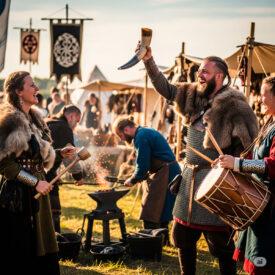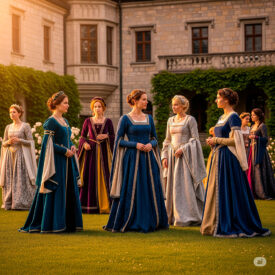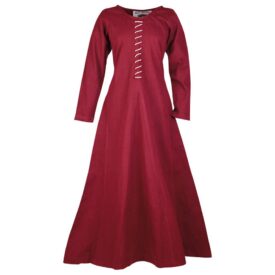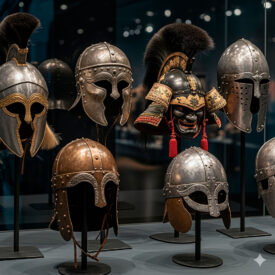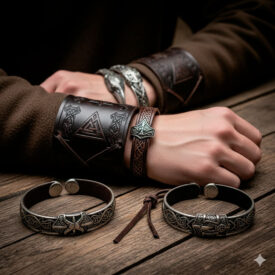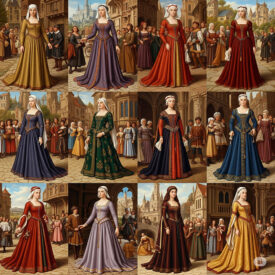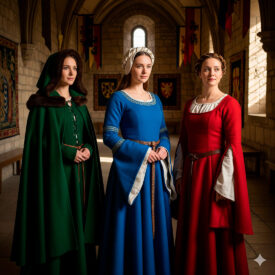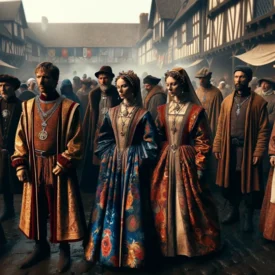The popular image we have of Vikings, often dressed in horned helmets and coarse furs, is far from the historical reality. Viking clothing was a sophisticated expression of their identity, social status and wealth. Far from being simple or uniform, the dress of these Nordic peoples, who lived between the late 8th and early 11th centuries, reflected their advanced craftsmanship and wide trading networks.
The Scandinavian peoples of Northern Europe wore very similar clothing: Vikings typically wore tunics, trousers and shirts with various patterns and decorations. They used different fabrics and made sure their clothes were not too tight to the body so as not to restrict movement.
The Fabric of Life: Materials and Production of Viking Clothing
Vikings were masters at using natural resources to create their garments. The main materials for their Viking clothing were wool and linen, chosen for their durability and availability in Nordic regions. These materials formed the basis of daily dress, providing protection and comfort in a range of climatic conditions.
Wool: the Essential Fiber
Wool was the most important material because of its versatility, warmth and durability. It retains its insulating properties even when wet, which was crucial for sailors and fishermen in harsh Nordic conditions. Sheep of the time were mainly white, so most wool was this color, serving as a base for dyes.
Linen: Lightness and Comfort
Linen, light, cool and pleasant to the touch, was obtained from the fibers of the flax plant. It was ideal for underwear and lighter summer garments. Its production was more labor-intensive than wool and therefore usually more expensive, often reserved for wealthier classes. This already gives a clue about the social status that could be inferred from Viking clothing.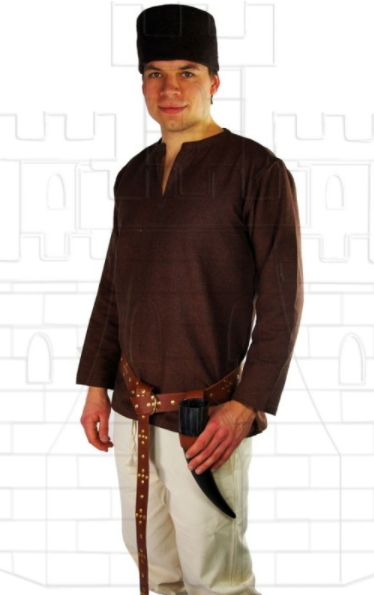
Furs, Leathers and Silk: Luxuries and Necessities
In addition to wool and linen, Vikings also used furs and leathers for warm garments such as coats and collars, providing extra protection against harsh weather. Leather was essential for footwear, belts and pouches. Silk, a luxury imported from distant places like Byzantium or the East, was a sign of opulence and used sparingly for decorative trims on elite garments. Silk and fine linen were more costly because they had to be imported, and only the wealthiest could wear them in vivid colors.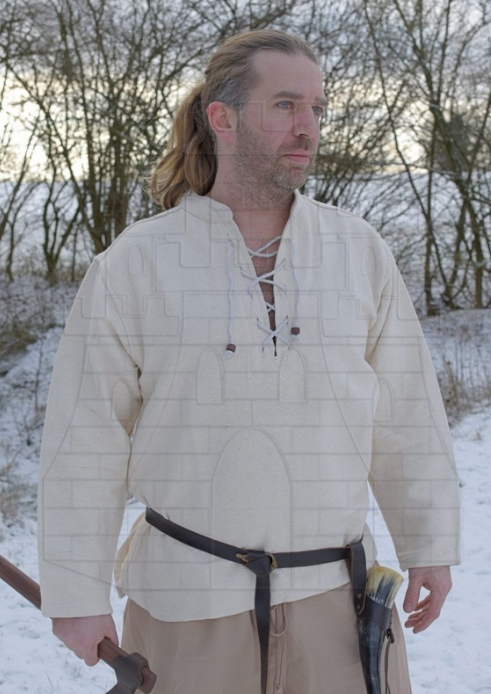
The Art of Color and Dyes in Viking Clothing
Contrary to popular belief, Viking clothing was colorful, although the natural dyes they used tended to fade over time. Vikings mastered the art of dyeing, extracting colors from plants, berries, lichens, minerals and even insects.
Viking Color Palette
- Blue: obtained mainly from woad (glasto/pastel).
- Red: extracted from madder or, for more valuable dyes, from cochineal.
- Yellow: achieved with weld (gualda), birch leaves or onion skins.
- Green: a combination of blue and yellow dyes.
- Brown and Black: using walnut husks, oak bark or iron-rich muds.
The quality and intensity of a garment’s color were a clear indicator of social status. Bright and rare colors were reserved for the upper classes, while common people wore garments in more natural or muted tones. Colors also had symbolic meanings: red was associated with power and wealth, blue with the gods and green with fertility. Vikings were attracted to brightly colored garments and shiny beads, revealing a society with a developed aesthetic taste.
Weaving Techniques and Construction of Viking Dress
Vikings were skilled weavers, using various techniques to produce durable and attractive fabrics. The warp-weighted loom (vertical loom with weights) was common in Nordic households. Techniques included plain weave (the simplest), twill (more complex, for strong fabrics) and herringbone (a twill variation creating distinctive V-shaped patterns). They also practiced nålebinding, an ancient hand-sewing technique predating knitting and crochet, to make flexible garments.
Garment construction was done ingeniously to minimize fabric waste, prioritizing functionality and durability. Sewing was done with bone or metal needles, and embroidery with colored wool, linen or silk threads served as decoration and as a status marker. Old clothes were not discarded but decorated with sewn-on bands and their color was changed over time, according to a study of remains found in Viking graves, demonstrating a strong sense of sustainability and appreciation for their garments.
Men’s Viking Dress: Functionality and Status
Viking clothing for men combined functionality with a reflection of social position, adapting to the demands of daily life and travel.
Tunic (Kyrtill) and Undershirt
The tunic (Kyrtill) was the central garment of male Viking clothing, made of wool or linen, and reached down to the knees. Underneath, an undershirt, usually linen, was worn. Tunics could have simple decorations on sleeves and collar, or woven bands that indicated the wearer’s status and wealth.
Viking Trousers: Variety and Adaptability
There was a wide variety of trousers in the Viking Age. They were often fitted and made of wool, held at the waist with a belt or cord. Variants included straight-cut (“Thorsberg”) or baggy styles, with or without pleats and could reach the feet or not. To protect against cold, damp or snow, they used straps or leg-wraps, like a sash, that reached to the heels.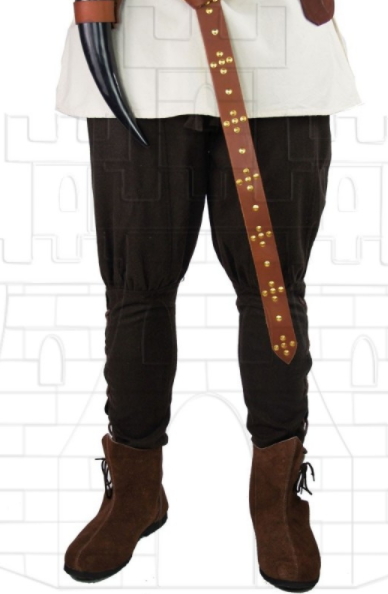
Trousers lacked pockets and fly openings and were fastened with a belt, which was decorated for special occasions and also served as a distinguishing element of their Viking clothing.
Leg-wraps or Bandages (Rastrojeras/Winningas)
They were wrapped from the ankles to the base of the knees, made of wool and fastened with a fibula or woven strip. They provided protection, warmth and extra support, being a practical and necessary component of daily Viking clothing.
Cloaks and Mantles: Protection and Symbol
Cloaks and mantles were long, thick and heavy, fastened at the right shoulder with strong straps or a brooch (fibula), leaving the right hand free for weapons or tools. They were important for protection against the weather and as status symbols. The cloak was a simple rectangular piece of woven wool or animal fur, used to protect from cold and rain. The cloak was fastened with a pin or brooch that could be made of bone or precious metals with Viking motifs.
Footwear and Accessories
Sturdy leather shoes and boots were the most common. They were often made from a single piece of leather using the “turnshoe” technique to make them waterproof. They were treated with grease or oil to keep them flexible and repel water. Socks to protect feet from cold and damp were made of wool.
Viking belts were made of leather and could be decorated with silver or bronze buckles. Essential tools like a knife and a leather or cloth pouch were tied to the belt. Since trousers had no pockets, a pouch was needed to carry belongings, making the belt an indispensable accessory in Viking clothing.
Hats were also made from wool, furry skins or leather and came in a variety of designs. Gloves and shoes were also made from these materials.
Women’s Viking Dress: Beauty and Social Role
Women’s Viking clothing also balanced functionality with style and status indication, showing the importance of the female role in Nordic society.
Underdress or Chemise
A long garment, often ankle-length, made of linen or wool, which served as a base layer. Some Viking women wore long undergarments, over which they put a long dress decorated with silver and gold threads that reached their feet, displaying wealth and social position.
Overdress (Hangerock)
Worn over the underdress, sleeveless and generally made of wool. It was distinguished by its straps, which were fastened at the front with artistically crafted fibulae or brooches. These fibulae not only served to close the garment but were important jewelry and status symbols within women’s Viking clothing.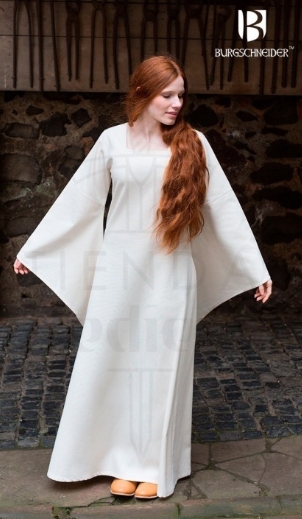
Cloaks, Shawls and Aprons
In colder months, women wore a cloak or shawl for protection. Aprons were practical for daily life, protecting clothes during work and could be decorated with embroidery or braids for festive occasions.
Headwear and Veils
Married women usually covered their heads with linen or silk headwear, the craftsmanship of which indicated their social position. There is also evidence of hats or caps for outdoor activities, adding to the complex ensemble of Viking clothing.
Belt and Pouch
Like men, they wore a leather belt to which they attached a pouch and a knife. Sometimes they hung useful objects from the fibulae that held their dress, demonstrating the practicality and need to have their belongings at hand.
Jewelry and Accessories: More Than Decoration
Viking jewelry was not just ornamentation; it had practical, symbolic and economic functions. There is better evidence of jewelry than of clothing, since metal survives the passage of time better. These accessories complemented Viking clothing and were often more durable than the garments themselves.
The Five Main Functions of Viking Jewelry
- Aesthetic ornament: to enhance personal appearance.
- Accessories to close clothing and/or fasten items: functional elements.
- Symbol of belief and protection: connection to the spiritual.
- Indicator of social or economic status: reflected the wearer’s wealth and position.
- Means of payment for trade exchanges: especially neck-rings and fragmented silver.
Materials varied by social class: the rich could afford bronze, silver (the most common metal) and gold jewelry, sometimes adorned with pearls, crystals and gemstones. The less wealthy used common metals, amber or glass.
Pins and Brooches (Fibulae)
They were the main means to fasten clothing. Their design could make them symbols of wealth, status and religion. Oval fibulae were popular in the 9th and early 10th centuries, replaced by disk-shaped brooches in the 10th century. Turtle-shaped fibulae were typical of the Viking era and a distinctive element of Viking clothing.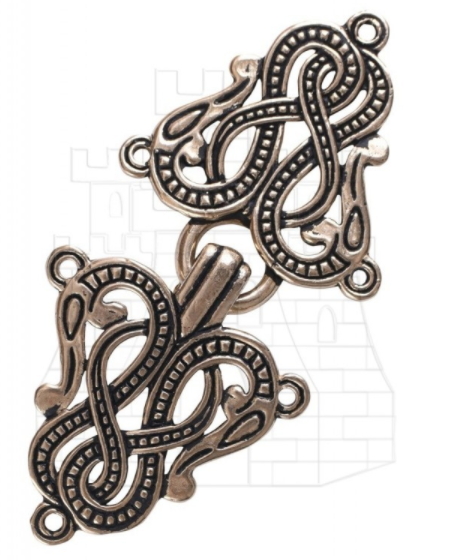
Necklaces and Amulets
Vikings wore necklaces and solid metal neck-rings (torcs), often used as currency. Necklaces frequently featured pendants with symbolic designs, intended to offer protection and support. Thor’s hammer (Mjölnir) was by far the most popular amulet. Other symbols included round pendants (solar star), miniature tools (activity/fertility), crosses (with Christianization), Odin’s spear (Gungnir), and representations of the thrones of Thor and Odin, or the Valkyries.
Clothing as a Status Symbol
Viking clothing was a powerful reflection of an individual’s social position. Jarls (leaders) and the wealthy wore garments of fine fabrics, often imported and combined with local materials, decorated with elaborate embroidery, valuable brooches and fibulae. Viking trade routes, which extended from North America to the Caspian Sea, significantly influenced their fashion, bringing a mix of styles and techniques. In contrast, free peasants and craftsmen wore simpler, locally produced clothing, though they also valued adornments, albeit to a lesser extent. The attraction to quality garments and the modification of pieces over a lifetime to stay fashionable show a sophistication that is often overlooked.
What Do We Know Today? Sources and Archaeology of Viking Clothing
Our knowledge of Viking dress comes from various sources, allowing us to reconstruct accurately what Viking clothing looked like:
Archaeological Finds
Although organic materials deteriorate easily and no complete example of Viking clothing has been found, textile fragments have survived. Discoveries in ship burials such as Oseberg and Gokstad have preserved textile remains that reveal information about materials, weaving techniques and patterns. Other important sites include Hedeby and Birka, providing valuable information about Viking clothing.
Contemporary Descriptions
The Icelandic sagas and accounts of Arab travelers, such as Ibn Fadlan, provide valuable details about Nordic clothing, complementing archaeological finds.
Pictorial Representations
Image stones (especially in Gotland) and miniatures in medieval manuscripts offer visual clues, although they must always be examined critically due to the artistic liberties of the time.
Current Historical Reenactment of Viking Clothing
Today, historical reenactment of Viking dress seeks maximum fidelity to archaeological finds and historical texts. A distinction is made between “Western Vikings” (Norwegians and Danes) and “Eastern Vikings” (Swedes and Rus), as their clothing and armaments showed differences due to trade routes and cultural influences. For example, in the context of Viking incursions into the Iberian Peninsula, they are considered to have been mainly of Norwegian or Danish origin, so Slavic or Eastern-influenced elements are not considered authentic for that reenactment.
Viking clothing, far from being simple or uniform, was a complex manifestation of their society, economy and beliefs. It reflected their ingenuity, adaptability and keen sense of aesthetics and symbolism. Through the study of their fabrics, garments and ornaments, we gain deeper insight into a rich and multifaceted culture that valued both functionality and beauty in every thread. If you are looking for the best Viking clothing for historical reenactment or simply for an authentic style, explore our selection and find pieces that will transport you to the era of the great Nordic seafarers.
SEE MORE VIKING AND MEDIEVAL CLOTHING | SEE VIKING TROUSERS | SEE VIKING TUNICS | VIKING SHIRTS

